India's Mughal Empire was powerful. It was the second of two Islamic empires to rule India from the 13th to the 18th century. The Delhi Sultanate was first. The Mughal Empire marks the pinnacle of Indian culture before the arrival of Europeans. Instead, it started modern India.
Mughal Empire under Babur
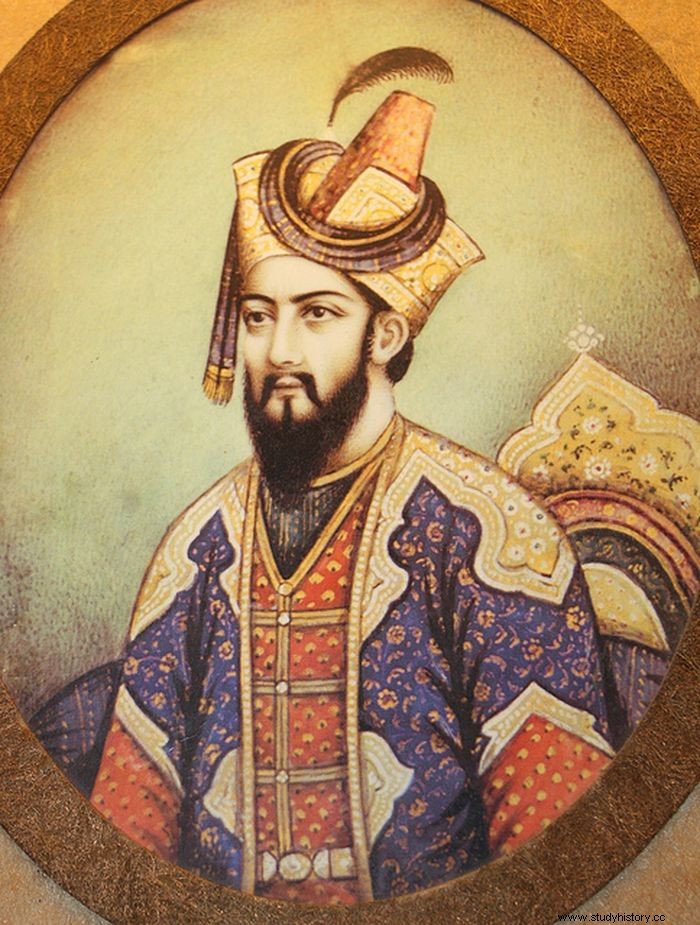
Babur conquered northwestern India in 1525. The king of the Delhi sultanate, which stretched over most of northern India, approached him. In April 1526, they fought at Panipat. Babur assassinated the last Delhi sultan there. Mongol-born Babur claimed descent from Genghis Khan. His descendants were called Mughals (Afghan for "Mongols"). Babur fought for three years in northern India until he won in 1530. But unfortunately he died without establishing order in the vast territory he ruled.
Mughal Empire under Sher Shah and Humayun
Humayun succeeded Babur. He fought against rebellion and could not retain his reign, and was forced from India to Afghanistan within the next decade.
One of Babur's former generals, Sher Shah, was his greatest opponent. He became a successful military leader and king of northern India. He restructured currency, taxes and roads.
Sher Shah died in 1545, as Babur before him. At his death, quarrels broke out since he had not had time to consolidate control. Humayun, who had been in Afghanistan, launched a successful counterattack and regained the throne in 1555.
Fate mingled again. Humayun died in his library the following year. Akbar, his 12-year-old son, consolidated the Mughal regime in northern India
Mughal Empire under Akbar The Great

In 1564, when he was 20 years old, Akbar gained control of his rulers. Akbar crushed all resistance, including significant uprisings. He expanded the Mughal empire across northern and central India and implemented measures that strengthened Mughal dominance. This was religious tolerance as most of his people were Hindus, and it was state centralization.
Tolerance
Akbar revealed his religious views by marrying a Rajput (and thus Hindu) lady. He removed the non-Muslim tax and brought Hindu nobility (especially Rajputs) into government. In line with his liberal religious ideas, he removed Islam as the official religion of the Mughal Empire.
Centralizing power
Akbar organized the provinces of the empire to concentrate the authority in their own hands.
Reform taxes
He explored the territories of the empire to improve tax collection. He rebuilt and polished Sher Shah's innovations. For example, he demanded that farmers pay taxes in cash instead of in kind and surveyed farmland to make it fair.
Roadworks
Akbar built roads to connect northern and central India with ports in Central Asia (and the Silk Road), Bengal and the Indian Ocean.
Capital
Akbar transferred the Mughal capital from Agra to Fatehpur in 1571. Despite the huge sums Akbar invested in the development and the magnificent palaces he built there, it proved to be insufficient for the job. It lacked water and could not host a significant population comfortably. 1585:He moved the capital to Lahore, then Agra.
Mughal Empire under Jahangir
Akbar died in 1605, leaving his successor, Jahangir, an extensive, peaceful empire. But, as usual in Indian politics, a dying ruler sparked a revolt. Jahangir encountered a mutiny from his son, not a nobility or general. Jahangir maintained Mughal progress in central India, although Persia's victories in Afghanistan offset progress. Rebellion and palace intrigue marred Jahngr's last year. Shah Jahan succeeded him in 1627. (reigned 1627-58).
Mughal Empire under Shah Jahan
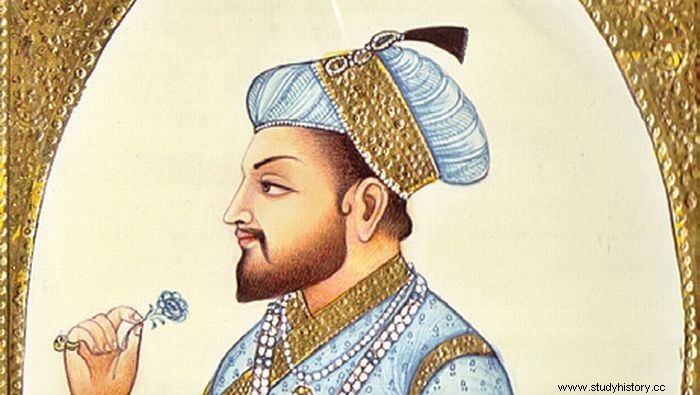
As usual, the palace intrigue destroyed Shah Jahn's legacy, culminating in the death of his brothers and cousins. Later in his reign, Mughal and Hindu leaders revolted
His reign witnessed significant Deccan development and the return of Afghan land lost by his father. However, missions in Afghanistan and Central Asia failed. Shah Jahan transferred his capital from Agra to Delhi in 1648 to fortify the northeast.
Shah Jahn protected art, and at his court he had the best poets and painters. He also built the unique Taj Mahal.
The reign of Akbar, Jahngr and Shah Jahn saw palace intrigues and revolts, but they were all dealt with smoothly and quickly, without harming stability and prosperity. Under these three rulers, the Mughal Empire grew and created great art and architecture. However, the long reign of the following emperor saw Mughals' fortunes change.
Shah Jahn's illness in 1657 triggered a war between four of his sons (1657-9). Aurangzeb succeeded, imprisoned his father and began his long reign. Shah Jahn died in 1666.
Mughal Empire under Aurangzeb's rule
Aurangzeb maintained the expansionist policies of his predecessors. His expeditions expanded the Mughal dominance further south, and the empire grew under him.
Theology
Even before Aurangzeb's arrival, Mughal's lost Hindu support, and his strict religious practice did not help. So Aurangzeb, a sincere Muslim who lacked tolerance for his predecessors, tried to reintroduce Islam as the empire's official religion. He reintroduced the non-Muslim tax and banned the construction of new Hindu and Sikh temples.
Rebellion
The Jats (a northern Indian tribe) revolted in 1669, the Pathans (an Afghan clan) in 1667 and 1672, the Sikhs in the 1660s (1675 saw their leader, Guru Tez Bahadur's dead), and the Rajputs from the 1660s to the 1680s. But, most dangerously (though it did not seem so), Maratha rebelled. Between 1655 and 1680, the Shivaji humiliated the Mughal armies and created the basis for future Maratha triumph.
Marathas
Aurangzeb managed these riots for a while. After a short hiatus, Marathas refused to concede defeat and resumed fighting. Aurangzeb used practically all their Deccan rule to deal with them. They gradually overcame Mughal troops. By the time of Aurangzeb's reign, they had asserted their independence from the Mughals and dominated large parts of southern India.
Taxes
Not only did Maratha's victory signal Mughal's passing. Aurangzeb's anti-Hindu and Sikh policies led to massive quiet opposition from the Hindu majority and their leaders in the areas. Many of Araungzeb's nobility fought against his measures and did not fully follow them. Because provincial taxes went down, taxes had to go up in areas controlled by Mughals.
Aurangzeb's death in 1707 shattered the Mughal Empire.
Mughal Empire control
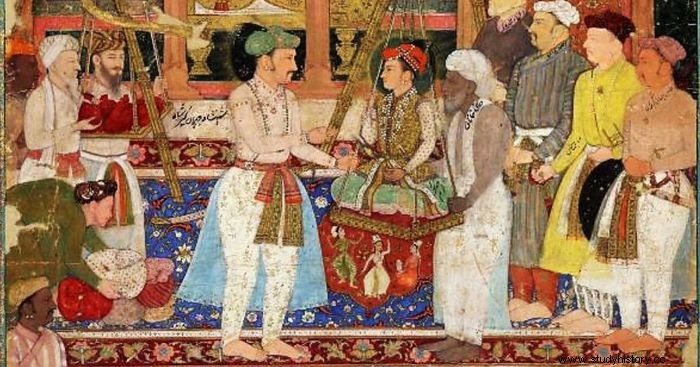
The Mughal Empire survived 150 years because it was well built. These were established during the reign of Akbar the Great.
Officials
The Mughals originated in Afghanistan when nobles shared authority with the king. Unfortunately, this was not a recipe for adequate, stable governance and contradicts Akbar's desire to exercise as much state authority as possible. He promoted many Indian Muslims, Persians and Hindu Rajputs to high rank in the Imperial Mughal service.
Mughal Empire Aristocracy
Akbar formed a unified imperialist aristocracy based on military ranks to encourage cooperation. The generation of tax money took place from land allocated to the members (mansabdar) based on their position in the organization.
These parts of the land were, in the Emperor's opinion, not hereditary and not for sale. Apart from collecting taxes, they had little state power over farmers and other residents. Depending on their rank, mansabdars had to give between 10 and 5,000 troops to the imperial army of the money they earned.
Men from the background mentioned earlier can come up in the imperial service. This service aristocracy was only half non-Indian, reflecting India's ethnic and religious diversity. Promotions and other benefits kept members loyal to their imperial masters.
Mughal Empire Administration
Centralized bureaucracy
Akbar created an effective central government with only four departments:prime minister, finance minister, chief of staff and chief of staff (who was also responsible for religious affairs). The emperor nominated and removed these ministers at his own request. The tasks of each department were explicit; thus, ministers had transparent personal responsibility.
Countries
The provincial government underwent bureaucratic streamlining. Each province had a governor, military chief, religious administrator and judge. This division of responsibilities creates conflicts and increases central authority over regional authorities. Agents in each province kept the court informed of what happened, which helped.
Locations
Each district had a military officer, tax collector, judge, public works (sanitation, police, administration), clerk and treasurer. In addition, cities and towns could afford far-reaching tasks.
Revenue Collection

Akbar and his ministers changed the income structure through trial and error to be fair to the peasants while generating huge government revenues. The ultimate scheme taxed farmers between one-third and one-half of their production. It assessed land productivity and crop growth, and copper coins paid the tax. Farmers had to sell products to pay taxes. It promoted market growth and expansion. This led to rural money lenders and grain traders.
Well-trained professionals operated the system. Local elites, especially Zamindars, supported it - local landowners. In exchange for tribute, the emperor's officials confirmed their views. This system was in place throughout the northern and central Indian heartland of the Mughal Empire, but it was never implemented in the border areas.
Coins
Akbar established a unified currency over the Mughal Empire when he reformed money. Copper coins were in use in the beginning. In the 17th century, silver from America replaced copper as a popular currency.
Mughal Empire Army
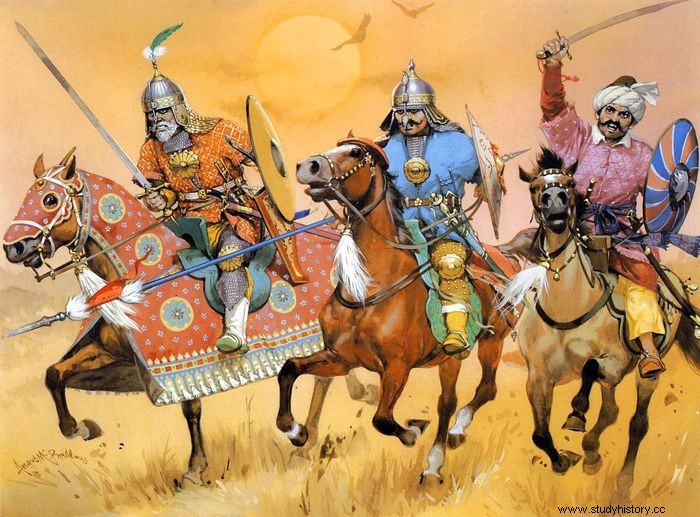
Weapons
The founder of the Mughal Empire, Babur, used rifles and cannons in his army. Modern academics regard the Mughal Empire as one of the three Islamic "powder empires"; the other two were the Safavid Empire and the Ottoman Empire. Babur used gunpowder weapons well in Panipat, and they became standard in the Mughal forces. Long before they appeared in Europe, rockets and grenades were in use. William Congreve modeled his rockets from the early 19th century on Indian rockets.
Organization
The formation of the military took place together with traditional Indian traditions. Infantry, cavalry, artillery and navy started the Mughal army. Different methods recruited them.
As we have seen, the Mughal nobility (mansabdars) were to recruit and maintain armies (along with the weapons and animals they needed) from the hunters given to them for their services. This action applied to public servants and soldiers. Mughal public workers were expected to be competent in both and able to switch at any time. In addition, the requirement from each mansabdar was to train cavalrymen and infantry.
Small Army
The usual standing army of the Mughal monarchs can be as small as several thousand. These were royal clan members or close relatives, and many were also palace officials and royal bodyguards. The standing military included artillery. Mansabdar cavalry and infantry troops formed the bulk of the Mughal army in emergencies or foreign wars.
Mansabdar strengthened the navy. It had a few battleships, primarily for anti-piracy missions, but its primary purpose was probably to ferry troops down the great rivers to where they were required.
Mughal Empire Society and Economy
Decision makers
The Indian economy multiplied during the Mughal dynasty. It benefited from the peace and stability of the empire, especially under Akbar, Jahangir and Shah Jahn, who ruled for a century. Mughal politics also increased prosperity. The Mughal administration developed, renovated and maintained the empire's roads, ports and river ports. Large-scale irrigation systems were also state-funded. In addition, Akbar's tax changes helped increase the market economy. Demand for luxury goods increased production and trade.
Banking
A growing banking sector increased India's money utilization. In addition, large bankers helped the Land Aristocracy and the Mughal Court engage in large-scale economic activities. Bills of exchange were used to transport money from provinces to the capital as the banking business developed. In addition, money changers and grain traders helped the farmers pay with coins. As a result, this era increased trade and production.
Exports
Textiles were India's largest export commodity. Until the mid-18th century, cotton textiles (especially calicos and muslin) dominated international trade. After that, the export of jute and silk took place heavily. Spices, peppers and indigo were among significant exports. Even the export of the powdered ingredient saltpeter happened.
Trade arrangements of this period favored India. European textiles, spices and other agricultural products could not meet European demand in India. Mostly silver bullion, which eventually came from America, was made into silver coins in India, which increased trade and production. The European Union, Southeast Asia and Japan were the three main destinations for the sale of Indian goods. Growth in foreign trade increased domestic trade. In addition, the urban elites' income and desire for luxury products improved.
Production
India produced 25% of all goods produced until the mid-18th century. Steel production (primarily for weapons) and shipbuilding were prominent companies in Mughal India. However, Europeans in the Indian Ocean and Southeast Asia rated Indian ship repair better than Europeans.
The needs of the cotton industry led to production technological innovations, especially the expansion of cotton gin, established under the Delhi Sultanate over India during the Mughal era.
Many farmers entered the economy for reasons other than paying taxes or cultivating export crops. Instead, many farmers supplemented their income with industrial work. Farmers, for example, bought raw cotton from merchants to spin yarn, and then resold it to make it into clothing. This transaction was the "putting-out" system, a proto-industrialization that mirrored Europe's industrial revolution.
Sowing the beans
Like other societies before the 19th century, India was agricultural. However, trade, industrialization and urbanization led to more market-oriented agriculture and less self-sufficient agriculture. During the Mughal dynasty, agricultural productivity helped increase India's population.
The Mughal government supported large-scale irrigation systems, but local groups built most of them. From the 17th century, corn and tobacco increased the farm's productivity. This method allowed the production of crops on unsuitable ground. They cultivated additional land - this increased agricultural production. The development of cotton farming led to the spread of cotton gin in Mughal India.
Mughal Empire population
Mughal India's population expanded rapidly. Estimates vary, but it probably doubled between 1500 and 1700.
Urbanization
Urbanization followed economic expansion. Delhi, Lahore and Agra were among the largest cities in the world. As the market economy developed, market towns spread throughout the empire. Fifteen percent of the empire's inhabitants lived in cities, higher than in Europe at that time and for a century or more.
Mughal Empire religion
At the time of the Mughal dynasty, the religious core boundaries of Indian civilization were obvious. Most Indians were Hindus, although a large percentage were Muslims. This fact was more important than the statistics indicate after centuries of domination by Muslim rulers, including the Mughal Empire. In Punjab, northwest of the subcontinent, a new religious group emerged when the Mughal Empire began.
Sikhene
Sikhs mixed Hindu and Muslim faiths. For example, Guru Nanak (1469-1539) preached that there is only one God, that all people are equal to him (no caste), and that following him means being honest and loving.
After Akbar, ties between the Sikhs and the Mughal Empire quickly deteriorated. Jahangir suspected that the Sikhs were planning against him and imprisoned, tortured and murdered Guru Arjun. This poisoned the Mughal-Sikh conditions. Sikhs militarized and fought against Mughal soldiers. With Aurangzeb's arrival as emperor, there was much persecution of them. They rebelled many times, contributing to Aurangzeb's suffering. Sikhs became a military power, especially in Punjab, northwestern India
Mughal Empire culture
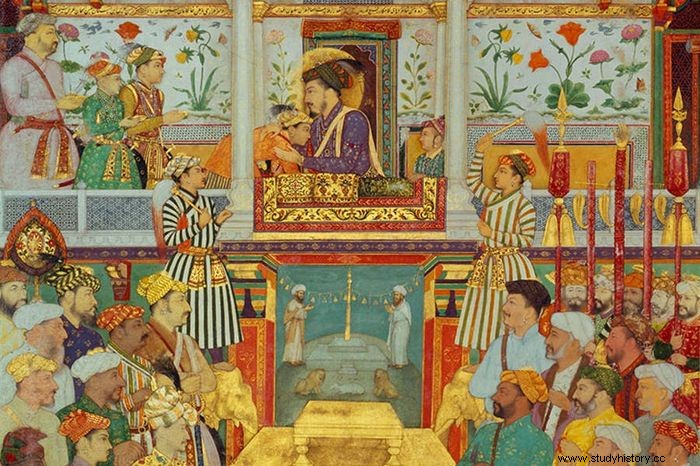
During the Mughal dynasty, Indian and Islamic literature, art and architecture merged. The Delhi Sultanate, the forerunner of the Mughal Empire, began this process. The Mughal Court was crucial to the empire's cultural development. It protected some of the most significant works of our time. Shah Jahan's reign was at its peak. The monarch gathered glorious Indian and Persian philosophers, poets and artists at his court. He commissioned the famous Mughal Peacock Throne and erected the Taj Mahal.
Literature
The Mughals spoke Persian. Not surprisingly, Mughals translated several Sanskrit writings into Persian. These included the Upanishads, the Bhagavad-Gita, the Ramayana and the Vedas. However, the Mughal court under Akbar, Jahangir and Shah Jahan was tolerant of Hindu works. Composing and reciting Persian poetry was popular in the Mughal court. Memoirs of Mughal rulers are considered literary masterpieces. Hindu literature was another example of Mughal tolerance.
Poetry, history, philosophy, science and translations and adaptations of famous Sanskrit texts flourished in the regional languages of India away from the court. Urdu began producing literature about this time. This new language developed in northwestern India when central Asians and Indians married. Under Mughals, this mixture of Hindi and Persian produced its literature and became a dominant Indian language and literature.
Art
The calligraphy and miniature art in the Mughal books were of the highest quality. In addition, there was the depiction of classic Persian and Sanskrit writings along with current originals. Not least were the memoirs of the beautifully decorated Mughal rulers. These tiny paintings covered portraits, court, hunting and war themes.
The Mughal court had its workshops, which established the standard for aesthetic splendor in the empire. Over time, Hindu monarchs and nobles in the kingdom produced Mughal-style paintings. This action emphasized the new realism and naturalism of art.
European art influenced Mughal royal painters after Jahangir. In the Persian tradition, the application of perspective took place from different points of view. In European style, a simple display was in use; as a result, the images became more realistic. The pictures of birds, flowers, animals and portraits were beautiful. Later, Mughal art became more rigid and rigorous. Yet, even after the fall of the Mughal Empire, great works were created.
Architecture
Indian influences were more prominent in a building than in art, where Persian forms mingled. Islamic-Indian architecture, which began under the Delhi Sultanate, achieved its magnificent culmination during the Mughal dynasty. The Taj Mahal, the tomb of Humayun, Fatehpur Sikri, the Red Fort, the Agra Fort, the Lahore Fort and the Red Fort in Agra are just a few of the world famous Mughal structures that still survive in Agra, Delhi and other parts of the North. India. In addition, Rajput and Sikh palaces and monuments have a solid resemblance to Mughal architecture.
Mughal Kingdom Decline
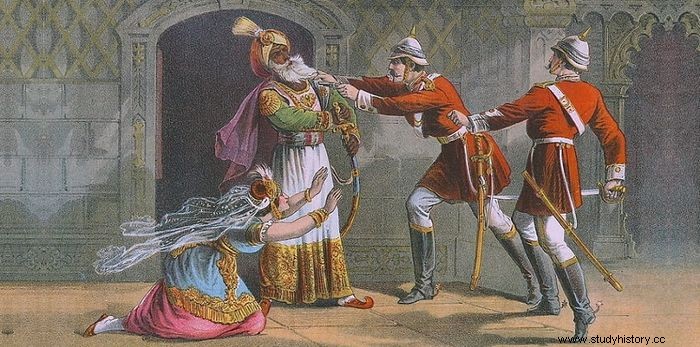
Aurangzeb's followers were more tolerant of Hindus. They removed non-Muslim treasures and faded the Rajputs and Marathas. These attempts were successful, but they confirmed the de facto independence of both groups.
Problems abound
The economy of the Mughal regime was serious. It could not adequately compensate its aristocrats and bureaucrats, and undermine their devotion. Castle intrigues, inheritance disputes and court favorites made the case worse. Eventually, political feuds broke out for the monarchy. In 1719, Farrukhsiyar was executed
Unchecked governors
In the absence of judicial review, provincial governors consolidated the authority. As a result, Hyderabad, Bengal, Orissa, Ayodhya and Punjab fell out of Mughal authority in those years. Concerned about receiving money, the provinces had no choice but to acknowledge the far-reaching power of these powerful governors in exchange for homage.
Abuse
In the 1730s, Marathas pushed north and east, capturing most of central India. In 1739, Ndir Shah's Persian army invaded India and destroyed Delhi, the capital of Mughal. He returned to Persia with priceless Mughal regalia. He pressured the Mughal court to give him most of Afghanistan and northwestern India.
Afghanistan chiefs regularly ravaged the northwestern fortifications of the Mughal Empire. Meanwhile, Marathas raided from central India.
Mughal Prestige
The Mughal emperor and his entourage remained a powerful emblem of power and authority. Afghans, marathas and increasingly autonomous governors wanted to dominate the court, not abolish it. They demanded its validity in order to retain influence over local communities.
By the mid-18th century, a confederation of regional princes had emerged, each expressing devotion to the mysterious Mughal emperors of Delhi, but pursuing their interests in conflict with the other centers of power.
Proxy Kings
The Mughal Empire no longer had a single center. Mughal rulers ruled in principle, but could not control the forces around them. Only Delhi and the surrounding area were under their control. The Mughal emperors became puppets when the British gained control of more of the subcontinent.
During the Great Revolt against the British in 1857 and 1858, the rebels used the last Mughal emperor to gather the Indian people and drive out the foreigners. The former Mughal monarch died in British captivity in exile
The conclusion
The Muslim Mughal rulers and their predominantly Hindu subjects made India's golden age full of art, scientific progress, and beautiful buildings. Later in the Mughal period, however, the French and British began to draw closer to the emperors. This proximity led to the fall of the Mughal Empire in 1857.
